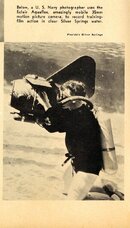I think some really good videos with side by side comparisons of just how much more efficient your system is over conventional gear would be a great starting point. Maybe something like a scuba drag race filmed from the side to give people anvisual of just how much faster anscuba diver is able to be? Seeing people in a pool alone doesn't give any scope.
i think open water swimming side by side still retains too many variables. leg power, weight, cross section, stamina, energy levels, rig configuration, etc etc.
there's two sides to the problem. one being drag/resistance, and the other is propulsive efficiency.
IMO, the only proper way to experimentally test drag/resistance is to drop down on an anchor line with a steady current, and tie off using some sort of a load cell. bonus points if you have access to one of those infinity circulating pools where you can control the environment more precisely. then record average loading over time for whatever gear configurations you wish to try out while remaining in trim without kicking. with or without BC. BP/W vs BCD. with or without nose/tail cones. drysuit vs wetsuit vs skin vs bare. with or without the tank even attached (monkey diving). etc etc. lowest loading == lowest water resistance.
lowering drag resistance is an easy sell; less drag = less effort = lower SAC = longer air supply limited bottom time.
propulsive efficiency is a completely different beast to test empirically. if you can constrain the water resistance, kick/glide tempo, and kick force (via SAC/time), then average multiple runs over a known distance, you might get something close to useful info. faster/farther travel for the same kick tempo / kick force / SAC == more efficient.
fun part is that efficiency does not remain correlated vs kick force and kick tempo. hate to use car analogies, but its sort of like an engine's torque curve, there's a sweet spot where things are at peak efficiency, and elsewhere, its less efficient. some engines, like divers, like fins, prefer to dig in and pull hard against a big load, while others like to rev high against a light load. even with such different personality, they both could theoretically result in the same MPG/eff% numbers for one pace, while having wildly different MPG/eff% for a different pace. so there is a need to break things down into components and test each component / variable independently: fast vs slow kicking, hard vs easy exertion, long vs short stroke.
until someone comes forward with a properly controlled, repeatable, and reproducible experiment, this is all hand waving and hearsay.









